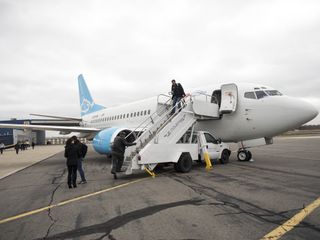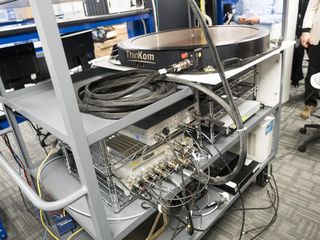Gogo's new 2Ku inflight Wi-Fi brings broadband speeds to the skies
Modern planes are a marvel of engineering. But inflight internet has gone from marvel to frustration. Gogo's new 2Ku system aims to fix that.

Flying isn't anything special anymore. In fact, between airlines squeezing more seats into planes, nickel-and-dime charges for bags and refreshments, and the dehumanizing and ineffective theater of airline security, flying has gone from amazing to nothing special to frustrating. One of the few solaces has been the expansion of customer options for connectivity — you can use your phone or tablet through the entire flight now, and bust out a laptop and hook up to in-flight Wi-Fi and get some real work done.
Chicago-based Gogo Inflight Internet has been at the forefront of in-flight internet access for two decades now. Its airborne internet systems are installed in more than 8000 aircraft worldwide, providing internet access to upwards of 80,000 of passengers a day.
There's just one catch: because Gogo's been at this for so long, a lot of those planes are flying with old equipment installed. Gogo's first-generation ATG (Air-To-Ground) system and successor ATG-4 system are still on thousands of planes and connect to a network of around 250 cell towers on the ground (not the same towers you use for your phone) to provide internet access for passengers.
Gogo's been feeling the pressure from competitor ViaSat-1 and Hughes, not to mention frustrated customers. As we've seen a proliferation of connected mobile devices, we consumers have become accustomed to having near instant access to the web anywhere we go. But in the sky is a different story. The service offered by ViaSat-1 and Hughes is, as you might imagine, satellite-based, and notably faster than the older Gogo ATG-4 service.
Gogo introduced its own satellite solution, Gogo Ku, in 2012. Working with Intelsat and AeroSat, the Ku-band service offered near-global coverage, including over large swatches of the Atlantic and Pacific oceans. Ku offers speeds of up to 30Mbps for the entire plane, but has seen limited deployment to just over 100 aircraft so far, mostly transoceanic flights on carriers like Delta. Not to mention that the antenna module that's installed on the top of these planes is relatively tall, and thus hurts the plane's aerodynamics and fuel efficiency.
The next generation of Gogo's satellite service is debuting now, called 2Ku. The name's really quite straight forward — a pair of Ku-band top-mounted satellite antennas instead of the one from before. The pairing of antennas is said to deliver up to 70Mbps downlink to the plane, though that's still divided up amongst all the passengers. An added bonus is that the antenna module is about half the height, thus not being such an aerodynamic hinderance bolted onto the top of the plane.

Gogo took us and 17 other travel and tech journalists on a short flight for the first public test of 2Ku, and we came away impressed. With 18 of us punishing the system with streaming video, large downloads, and speed tests — most doing that on multiple devices at once — we consistently were able to get around 15Mbps down. Granted, because this was a satellite system, we were also looking at consistent 500-700ms ping times (your request is blasted up to a satellite, then relayed to the ground, goes through the terrestrial internet, back up to the satellite, and then finally back down to the plane — all in about half a second). Upload speeds also weren't phenomenal, sitting around 0.7Mbps up (we saw a peak in our testing of 1.1Mbps up and a peak download speed of 23Mbps).
Get the Windows Central Newsletter
All the latest news, reviews, and guides for Windows and Xbox diehards.

So what can you actually do with that sort of connectivity? We were able to stream 4K 60fps video from YouTube, get Netflix in 1080p, and check out Gogo's new live TV service. That was at the same time. On one computer. 17Mbps is actually about 50 percent faster than the average U.S. home internet connection, so most users should expect browsing and streaming on 2Ku to closely match their experience at home and on their phones.
That said, there are some things that don't work so hot, and that comes down to the painful ping time and pitiful upload speeds. While a few of my fellow fliers were able to broadcast live video to the world with Periscope, my attempts all failed, as did live video Google Hangouts. Gogo's prioritized download speeds with 2Ku, and that makes sense given how normal people actually use the internet — they're consumers of content and occasional uploaders of photos and short video.
In keeping with that focus on media downloads, Gogo's also setting up its own live television service for use on 2Ku. Currently the service offers Bloomberg TV and One World Sports, and they come through with crystal clear video and audio. Gogo's working with other TV channels to get more live content onto 2Ku, and is leaving the option open for airlines to negotiate their own channel packages as well.
All told, in our hour of flight, the 18 journalists on board pushed and pulled 11GB of data through the pair of satellite dishes on the top of Gogo's test plane. We were a relatively small sample size, yes, but also a voracious one. We were atypical of what Gogo expects from normal consumers (after all, they still charge for access to the service). The 2Ku started to show signs of strain in the latter quarter of our flight, with download speeds dropping as low as 4Mbps, pings stretching to over 1000ms, and upload speeds bottoming out at 0.13Mbps.

Gogo wants all of this 2Ku bandwidth to reach beyond just delivering content to the passengers in the cabin. They're also designing tie-ins to avionics and cabin service, with the end goal of bringing more data to what's an otherwise relatively isolated vehicle — especially when mid-flight somewhere over the Pacific.
If you find yourself on one of those 500 2Ku planes, you'll actually get a useful experience out of it.
Those applications, though, will take longer to roll-out. It's one thing to get FAA and FCC approval to put a new set of antennas on the roof. It's another to get the FAA to sign off on bringing up-to-date weather and air traffic information into the cockpit or broadcasting of live diagnostics to mechanics on the ground. Those are all potentially good things for aviation, yes, but also given the potential for catastrophe when a few we're talking about a few hundred tons of steel and people, it's okay for the FAA to take its time.
So far Gogo has seen 2Ku installation commitments from eight airlines for more than 500 aircraft, including airlines like Delta, Virgin Atlantic, and Aeromexico. In fact, Aeromexico just received approval from the FAA for use of 2Ku antennas on its aircraft, and should start offering Gogo 2Ku service onboard equipped flights soon. Delta's committed to installing 2Ku on 250 of its aircraft.
It's going to be a while before we see Gogo 2Ku service roll out to aircraft around the world. The current fleet of 8000 Gogo-equipped planes is dominated by the ATG and ATG-4 service in the US, and 500 2Ku planes will be just a drop in the bucket. But if you find yourself on one of those planes, you'll actually get a useful experience out of it.

Derek Kessler is Special Projects Manager for Mobile Nations. He's been writing about tech since 2009, has far more phones than is considered humane, still carries a torch for Palm, and got a Tesla because it was the biggest gadget he could find. You can follow him on Twitter at @derekakessler.

